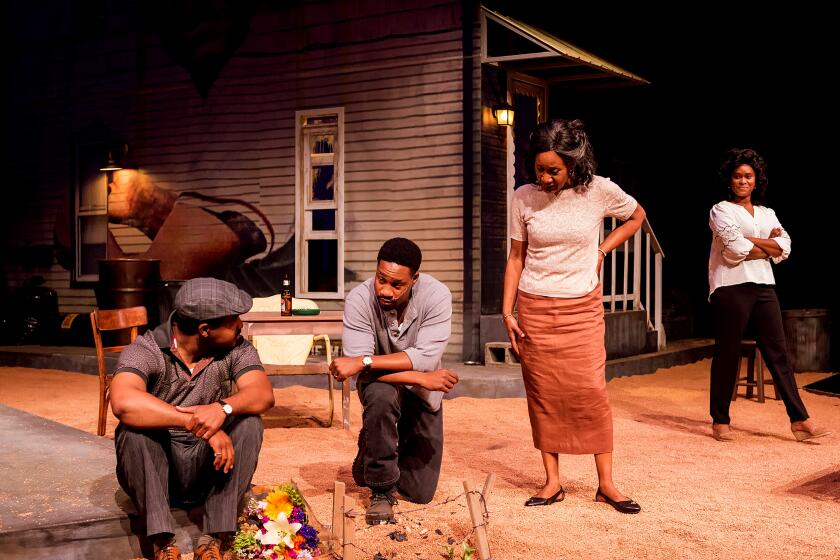Simon Rattle’s farewell tour with the Berlin Philharmonic swings into L.A. and Costa Mesa
On the morning after conducting the Berlin Philharmonic in two concerts at Carnegie Hall recently, Simon Rattle was in a car on the way to Boston and dialed up a reporter in California. “Oh, don’t worry,” he assured the interviewer, who wondered if Rattle was behind the wheel. “It’s hard to say this to someone from Los Angeles, but I can’t drive.”
The Carnegie concerts had been a memorable experience, the still elated British musician said, for more than one reason, the recent presidential election among them. “No political comments apart from saying that what an extraordinary time to be in America,” he said “You could feel the emotion in the audience and of course all the way around on the streets there.”
But these were also Rattle and the orchestra’s final concerts together at the historic venue. In 2018 Rattle will step down as music director of the ensemble, which he has led since 2002. The current tour, which stops Saturday at Disney Hall and Sunday at Segerstrom Concert Hall in Costa Mesa, is the conductor and orchestra’s last in North America together.
“Look, we’re trying not to think about everything being at an end,” Rattle says. “It sounds too much like a funeral.” Ultimately, though, he thinks it’s probably good that he’s leaving. “Orchestras need to kind of regenerate and follow new paths, and so do conductors. But I love them dearly and yes, it’s sentimental, sure.”
SIGN UP for the free Essential Arts & Culture newsletter »
Long considered among the two or three greatest orchestras on the planet, the Berlin Philharmonic, led in the past by such momentous figures as Wilhelm Furtwängler and Herbert von Karajan, was once best known as a luxurious band of virtuosos and caretakers of the great Germanic repertoire, from Beethoven to Brahms, Bruckner and Mahler. Rattle has sought to honor the brand as well as take it in different directions.
“I do think that, first of all, the orchestra is in really wonderful shape,” he says, looking back on his accomplishments there. “And I really do think that they have become very, very much more flexible and open to all kinds of things. Just this year having played so much of John Adams’ music and having him as composer in residence and having him meet the orchestra for the first time and everybody fall in love with him — I mean that’s a very good kind of pointer toward where it’s all gone.”
The L.A.-area concerts are also a homecoming for the 61-year-old Rattle, who served as principal guest conductor of the Los Angeles Philharmonic from 1981 to ’94. He still has many friends here. Next year marks a return to Britain for the Liverpudlian, when he becomes music director of the London Symphony in September.
Rattle has been campaigning for a new concert hall to be built in London and seemed to be making headway. But the new, post-Brexit government withdrew its support this month. Rattle says he’s “desperately disappointed, yes, but discouraged, no.” He intends to carry on.
“Look, we in England are very good at making plan B, and we have to see what plan B can be and how creative we can be and what are the possibilities. So I think the answer is ‘watch this space.’”
Conducting the Berlin Philharmonic is a joy and a challenge, Rattle says. “The better the orchestra, often the harder it is to conduct, not the other way around.” A great orchestra, he says, creates more musical possibilities to explore. Plus, with an orchestra like the Berliners, players seem to have their own opinions on how a piece should go. “In an orchestra with so many huge personalities,” he says, one of his main jobs is “to make it move in the same direction.”
The two tour programs, both of which will be performed here, are heady affairs. The first couples Boulez’s “Eclat” with Mahler’s seldom-performed Symphony No. 7, which Rattle says was Boulez’s favorite of the Mahler symphonies. The two pieces share a sound world (including bells, mandolin and guitar) as well as a certain “illogic” in the way they unwind. Boulez “often talked to me about the idea of how fish moved, how they suddenly move and suddenly stop and you never know quite where it was. That of course is an incredibly important part of his music, but also the Mahler 7th.”
The other brings together three early atonal works by the composers of the Second Viennese School — Schoenberg’s Five Pieces for Orchestra, Webern’s Six Pieces for Orchestra, Berg’s Three Pieces for Orchestra, played as a single, multi-movement work — with the Symphony No. 2 by Brahms. In concert, the Brahms symphony, Rattle says, comes like a “benediction” after the “apocalyptic music” of the three modernists.
All of this music is in the Berliners’ DNA. Especially the Brahms. Rattle cites a double bass in the orchestra that dates back to the composer.
“It played the Third Symphony conducted with Brahms,” he says. “It has a lion’s head. I often go and have a little chat with it before I am going to bless Brahms.”
------------
Simon Rattle conducts the Berlin Philharmonic
When: 8 p.m. Saturday at Walt Disney Concert Hall, L.A.; sold out. Also 3 p.m. Sunday at Segerstrom Concert Hall, Costa Mesa; $100-$350 (subject to change)
Information: L.A. Phil, (323) 850-2000, www.laphil.com. Philharmonic Society of Orange County, (949) 553-2422, www.philharmonicsociety.org

The Los Angeles Philharmonic’s YOLA holds a 10th anniversary tour with stops in Northridge, Visalia, Fresno and Oakland.
Follow The Times’ arts team @culturemonster.
ALSO
Times music critic Mark Swed’s latest reviews
Pianist Garrick Ohlsson packs Disney Hall for a thrilling, sometimes punishing, performance
‘Miss You Like Hell,’ an immigration musical for the new Trump era
More to Read
The biggest entertainment stories
Get our big stories about Hollywood, film, television, music, arts, culture and more right in your inbox as soon as they publish.
You may occasionally receive promotional content from the Los Angeles Times.






